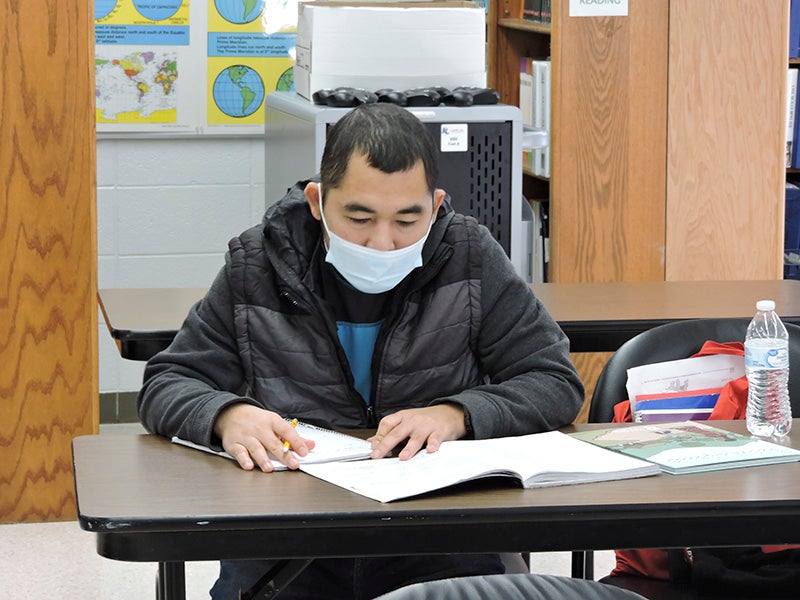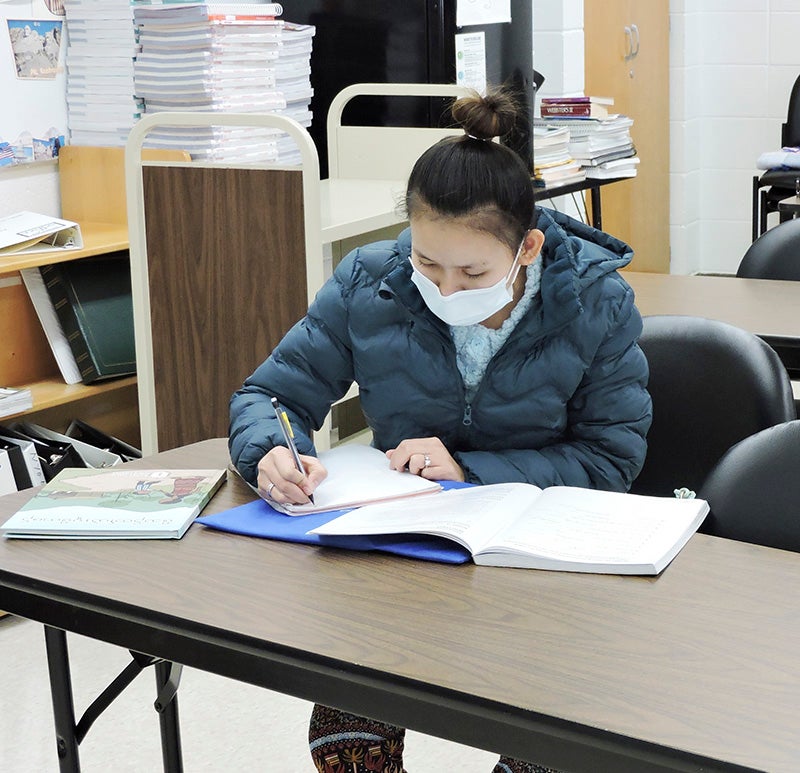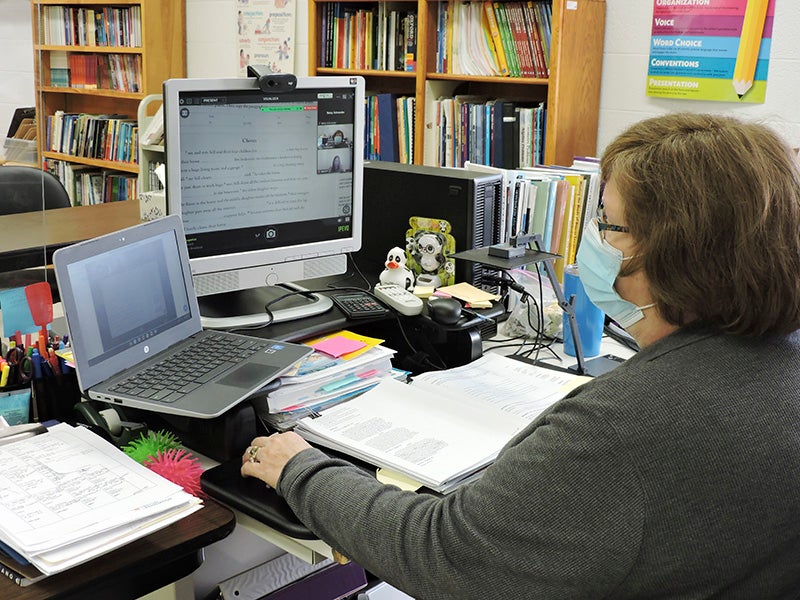Learning to speak a new language
Published 7:00 pm Wednesday, March 2, 2022
|
Getting your Trinity Audio player ready...
|
Though numbers have dropped during the COVID-19 pandemic, students press on in Adult ESL program
By Kelly Wassenberg
Rules are everywhere. They’re a way to ensure order over chaos. They let people know what is to be expected of them in certain situations.
Unfortunately, the English language doesn’t concern itself with rules.
“That’s what’s hard about English,” said Betsy Schroeder, English as a Second Language teacher in the Adult Education Center through Albert Lea Area Schools. “Every time English makes a rule, they break it. And that’s the hardest thing is that [the students] are just starting to learn a rule and then they run across something that breaks that rule.”
Schroeder and her students often laugh about it.
“Why do we make rules if we break them?” she said.
Schroeder has been an ESL teacher for 23 years and teaches the advanced ESL students.
Penny Jahnke, the adult education coordinator, said the program is serving 141 students from 16 countries covering 11 different languages — the most popular of which is Karen followed by Spanish. Students range in age from 16 and up, and their educational levels vary greatly.
Some come from countries in which women do not attend school and don’t even know the alphabet. Others have degrees in their home countries, but need a better understanding of the English language to be able to utilize that knowledge in a career here in the United States.
Most of the students are refugees, including Rau Htoo, 38, and Shay Lay Moo, 20.
Htoo is a refugee from Myanmar, who spent 10 years in a refugee camp before coming to the United States. This is in his second year of the program.
Htoo said his decision to come to the United States was based on the opportunities the country has to offer and was able to learn some English before immigrating to the country.
“America is a good place for refugees,” Htoo said.
Htoo is one of many who work full-time jobs on top of coming to class in order to increase his understanding of English in all its forms — spoken, written and read.
Moo was born in a refugee camp on the Thailand-Myanmar border. While she did receive an education, English was not taught at the camp. She works in the community and is learning English in hopes of getting a better job to help support her family. She has been in the ESL program for five years.
It takes a lot of dedication for ESL students to stick with the program.
“We have students who are working 10-hour shifts, and then are coming to school,” Jahnke said. “These students that are coming to school are probably some of the most hardworking and dedicated students you can find.”
Of those currently enrolled in the program, she reported 61% of the students work full-time jobs with many of the others staying at home to raise their children while their spouse works.
Regardless of their situation, the Adult Basic Education program tries to remove all the barriers it can by providing both transportation and day care assistance. Computers and mobile hotspots are also available so students can learn on their own time, as well.
Classes run Monday through Thursday from 8:30 to 11 a.m. and 11:30 a.m. to 1:30 p.m. Many students consistently make it to class, while it’s a struggle for those who work overtime at their jobs. Since COVID’s arrival, Schroeder said her class attendance has slipped from 16 to at times just a handful, but Jahnke said they are working on ways to accommodate. They are looking at providing night classes as part of a consortium and have been working on a high-flex model.
“We have students that are sitting at home, zooming in and watching class, while the teacher is also teaching a student sitting in front of her, and that has been very successful,” she said.
Flexibility is important as students must log between 40 to 50 hours of classroom instruction before they test to go up to the next level. There are six levels in total — three in the beginner classes and three in the advanced class.
“The immigration population is contributing to Albert Lea and Freeborn County,” Jahnke said. “They are filling jobs at our production plants. They are buying houses. They are having their children come to our schools. I only see positives about the people who are coming over here. They are hard working and very family-oriented.”
Say what? Grammar rules/exceptions for ESL
There are many common spelling rules most are familiar with, yet there are exceptions. When thinking of these rules, it becomes easier to imagine why a non-English speaker may have difficulty mastering the language. Below are just a few.
- I before E except after C — or when the letter combination makes the A sound — such as weigh and neighbor. There are still exceptions to this exception as the EI in height does not make the A sound.
- If C is followed by E, I or Y, it typically makes the S sound, such as cell, circle or cynical; but if the C is followed by an A, O or U it will usually have a K sound, such as car, cold or cue. The same rule applies to the letter G, which makes the J sound in words like gem, giant and gymnasium, but makes the G sound in words like gage, go and guerilla. There are exceptions to these rules including the word girl that makes the G sound instead J.
- When two vowels go walking, the first one does the talking — such as dream, pain and coat. Exceptions include bread, poem and guest.
- When pluralizing a noun that ends in Y, change Y to an I and add ES, such as penny to pennies, the exception is if the Y is preceded by a vowel. Boy only needs an S to make it plural.
- When pluralizing a word that ends in F, the F is changed to a V and an ES is added, such as elf/elves and loaf/loaves. However, if a word ends in a double FF, such as riff, only an S is needed to pluralize the word.
- VCV stands for vowel-consonant-vowel. In words like these, the second vowel is silent and makes the first vowel say its name like in words like cake, made and bike. Exceptions to the rule include the word lemon, which is derived from French.
- Some words ending in O have an ES added to them when pluralized, but not all. For example, potato changes to potatoes, but the word photo changes to photos.
- For many words, the Y ending must change to I when a suffix is added. Funny becomes funnier and ready becomes readily, but there are exceptions such as shy which becomes shyly.
- Dropping the E is a pretty consistent rule when adding suffixes for words such as write which becomes writing and sense which becomes sensible. Exceptions occur in words ending in CE or GE in which the C or G sounds remain soft such as courageous and noticeable.
- Pluralizing animals can be quite confusing for those not native to the English language.
- Deer remains deer in its plural form, as does fish, sheep and moose. Mouse becomes mice. Ox becomes oxen. Goose becomes geese. To make octopus and hippopotamus plural, the words change to octopi and hippopotami, or you can add an es to make octopuses and hippopotamuses. Either one is correct.
- When nouns end in ch, sh, ss, x or z, the letter combination of ES is used to indicate pluralization, such as beaches, wishes or boxes. There are exceptions to this rule such as stomachs and monarchs. This exception applies when the CH makes a K sound.
- The 1-1-1 rule states when words of one syllable ending in a single consonant immediately preceded by a single vowel, double the consonant before a suffixal vowel, such as running or jogged. This rule does not apply to words ending in V, W or X.






